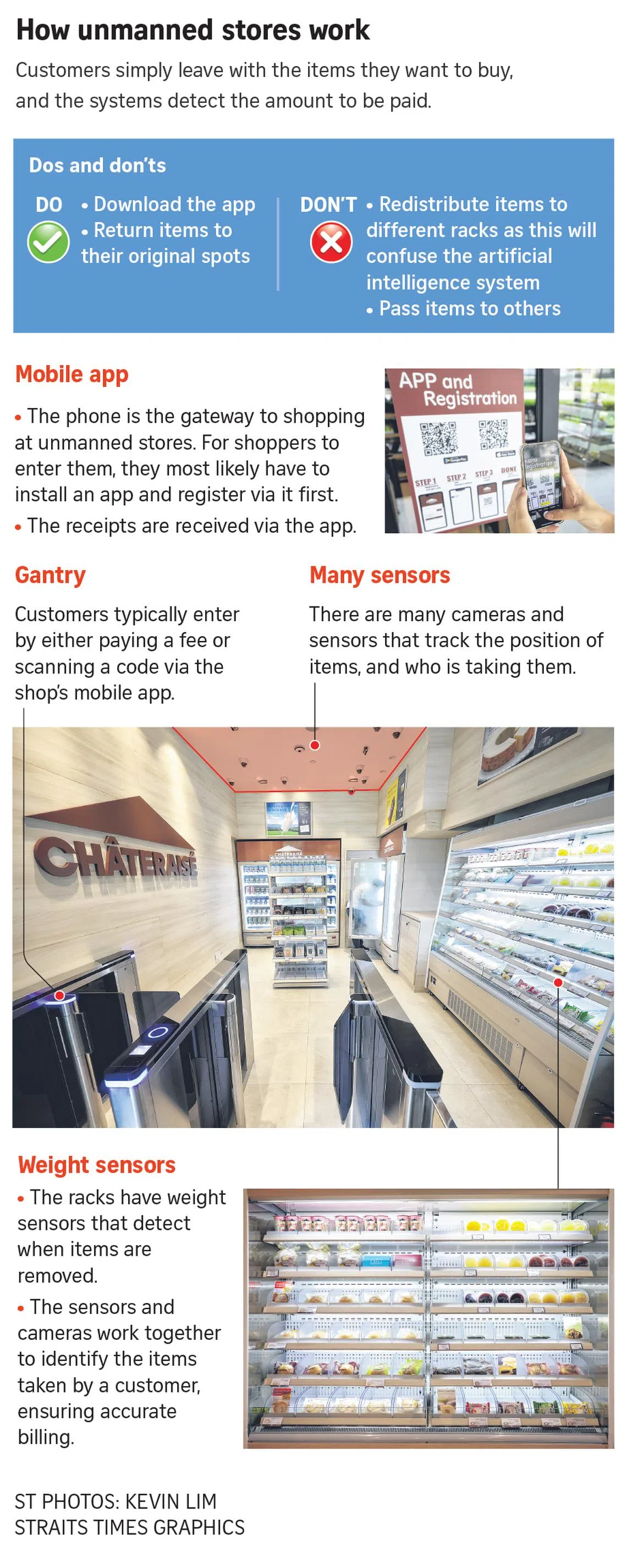Stress test: AI systems at unmanned shops easily confused by different situations
Sign up now: Get ST's newsletters delivered to your inbox

7-Eleven’s Shop & Go outlet had not recorded any customer issues since it opened in January, said its spokesman.
ST PHOTO: KEVIN LIM
Follow topic:
SINGAPORE – Unmanned shops have been touted as the retail outlets of the future, but tests conducted by The Straits Times found gaps in the experience that could keep shoppers away.
The artificial intelligence (AI) systems are easily confused, overwhelmed by multiple shoppers, and at times, they can bill the wrong buyer.
The test was conducted in the light of the closure of Amazon’s unmanned stores in the United States, which allowed customers to simply carry their shopping out of the store without having to queue to checkout.
At least 18 of such outlets have opened in Singapore, including 12 unmanned Cheers outlets, four Pick & Go stores and, most recently, Chateraise’s first AI shop outside of Japan in Bukit Batok.
To enter stores run by Pick & Go and Chateraise, customers must first install an app, which generates a code for them to scan to enter, and displays their receipt after they leave with items from the shop.

Many cameras and sensors track the movement of items in Chateraise’s unmanned store to help ensure shoppers are billed correctly.
ST PHOTO: OSMOND CHIA
Meanwhile, 7-Eleven, which launched its first unstaffed store in January,
Cheers’ outlets offer both options to customers.
To detect which items are taken, many cameras are installed across the ceiling of each shop, and weight sensors are found on the racks. Together, these help to ensure that shoppers are billed correctly.
The test
Four reporters from The Straits Times tested how the unmanned systems would cope with real-world shopping situations at two stores: the 7-Eleven at Esplanade MRT and the Le Quest Mall’s Chateraise outlet.
The scenarios:
The shoppers are taking the same item (one for each person) at the same time before exiting.
The shoppers are reaching across one another’s arms to take different items at the same time.
One shopper is taking four of the same items and then distributing them to the others before exiting.
Four shoppers are shifting items to racks with different price tags before leaving the shop with an item each. The cheaper item is taken to avoid underpaying the store.
One shopper is picking up an item that has been left on the floor by another shopper and exiting with it.
A shopper is entering with a purchased item in a bag, before leaving without any new item.
The team left the shop with the items after each scenario and waited for the receipt, or up to five minutes, before re-entering the shop to start the next scenario.
Findings
ST’s tests show that the AI systems can be easily confused whenever multiple shoppers picked up items simultaneously, redistributed items or moved them to different racks.
The result: Some buyers were not charged. At other times, they were charged for another buyer’s purchases. The shopping experience at 7-Eleven was made even more confusing as it did not provide an itemised receipt, so shoppers could not tell for sure what they were charged for.
Chateraise’s systems were able to correctly bill each buyer even when the team members reached across one another’s arms to take various items. However, the systems sent the wrong bill when items were switched around on the shelves for items with different prices.
The system was also confused when a shopper picked up an item that was left on the floor of the shop before exiting with it. In this case, the shopper who placed the item on the floor was billed, despite never leaving the shop with the item.
When it came to the helpful shopper who took items off the shelves for others, both Chateraise’s and 7-Eleven’s systems billed only that one shopper. The others who walked out of the shop with the items distributed to them were not billed. So it doesn’t pay to be too helpful in unmanned stores.
Within minutes of exiting the store, Chateraise provided an itemised bill on its mobile app, which gives customers a detailed breakdown showing each item, a picture of it, the amount charged and whether the payment was successful.

Customers of Chateraise’s unmanned outlet enter using a mobile app, which displays an itemised bill after they leave with items.
7-Eleven, however, did not provide itemised receipts upon exit, making it difficult for shoppers to tell when the system overcharged them or missed charges. In our tests, some shoppers who left without buying anything had to wait up to 14 days before the $5 entry fee was returned.
While shopping at unmanned outlets is convenient and generally swift, customers will need to adapt to more rigid shopping practices in order to ensure their transactions are recorded accurately.
A Chateraise spokesman said notices have been placed in-store to remind customers not to pass items to one another to avoid inaccurate transactions. The AI-powered system identifies customers through the QR code used to enter the store and monitors their shopping activity, updating their virtual cart in real time as they pick up items from the shelves, said the spokesman.
The system, for now, is unable to adapt to other behaviours.
7-Eleven’s Shop & Go outlet had not recorded any customer issues since it opened in January, said its spokesman.
“While we acknowledge that all technologies have their limitations, we want to assure our customers that these limitations rarely occur in our store’s environment. We continuously strive to improve our systems based on the feedback we receive and conduct regular assessments to ensure optimal performance,” said the spokesman, adding that any inappropriate behaviour will be reported to the authorities.
Additional reporting by Ariel Yu, Whitney William, Leow Wen Xuan and Shabana Begum


